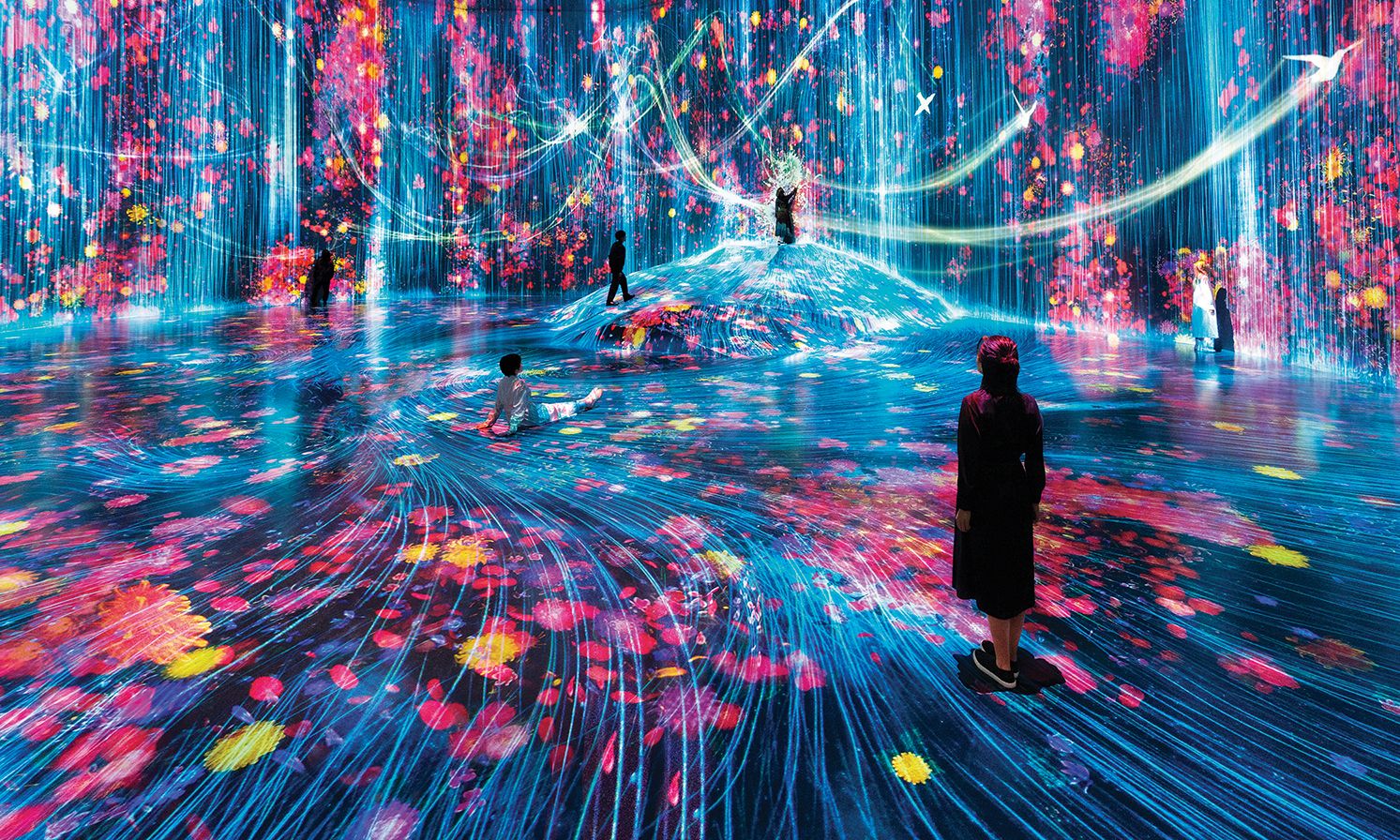Waterfalls of light: Universe of Water Particles on a Rock where People Gather (2018/2024), teamLab Borderless, Azabudai Hills, Tokyo © teamLab, courtesy Pace
One of the most striking installations in the immersive art museum known as teamLab Borderless, which opened in Tokyo’s Azabudai Hills complex in February, has the makings of an aquarium. But instead of standing watching fish swimming past behind glass, you are right there in the churning flow of things: schools of glinting goldfish forming and darting off, inky waves swirling and swelling, and the action projected all around you. It is a 3D, digital, fever-dream version of Monet’s waterlily paintings, and arguably the apotheosis of those paintings, also designed to bathe you in colour. It is a fluid and iterative work of art, never the same ocean twice. It is both glorious and disorienting, and accounts for one of several moments in the museum where my husband said he felt dizzy. Or, as my nine-year-old said afterwards: “It was all amazing but also kind of nauseating.”
We had just flown from Los Angeles to Tokyo for a big spring-break trip with our kids, and teamLab Borderless, the collective’s most ambitious museum yet (replacing one of the same name in the Odaiba district that set a Guinness World Record for attendance), was high on our to-do list. For the kids, aged nine and 14, it was up there with the eight-storey stationery store Ginza Itoya and the electronics megamart Yodobashi Akiba as the pinnacle of something. For me it felt like the next step in my halting journey into immersive art, ranging from rain rooms and mirrored infinity rooms early on to Sphere in Las Vegas last year but not including any teamLab meccas, which are fast expanding beyond Asia to cities such as Hamburg and Abu Dhabi. Like many other professional museum-goers of my generation, I’m still wondering: what do these spaces offer beyond some cool selfies?
Judging from my kids’ experience, one answer is full-body joy. After years of dragging them through museums, this time it felt like they dragged me. They explored teamLab Borderless—a 7,000 sq. m spread that is hard to mentally map because floor plans and wall labels are deliberately missing, and imagery from one artwork spills over to another—as if it were a playground, rushing to try and pressure-test the equipment. My daughter was quick to touch the walls, triggering flurries of butterflies or bursts of colour, while I was treading slowly, trying to distinguish real walls of plaster from digital walls of light and recalling the woman who famously fell into a James Turrell installation at the Whitney when she leaned against it. (In the artist’s version of the story, the real damage was caused by the lawsuit brought against him by her husband, who was a judge.)
While enjoying some of the effects, I was trying to figure out how the magic was manufactured. A collective of artists, programmers and more that won’t even reveal its size, teamLab is not known for embracing an open-source ethos like, say, Refik Anadol; its tech secrets tend to be closely guarded. I had a hard time even figuring out materials or media.
One installation looks like a crystal ball factory, with hundreds of colourful, blinking orbs travelling on an elaborate system of tracks, multiplied I suspect by a Kusama-style mirrored-room set-up. “It’s a glittery portal of the imagination,” said my daughter, over the hum of the New Agey music. “It looks like an elaborate marble run,” I said, frustrated that I couldn’t distinguish projection versus reflection versus solid. Over her objections, I reached out to touch an orb: to my surprise it felt nice and glassy. And soon we were off to another LED dazzler: a forest of tiny lights that recalls Erwin Redl’s Matrix II from the 2005 survey Ecstasy at the Museum of Contemporary Art (Moca), in Los Angeles, Paul Schimmel’s important (and now prescient) showcase of immersive art.
Bubble Universe Fire White (2023), teamLab Borderless, Azabudai Hills, Tokyo © teamLab, courtesy Pace
By this point we had lost track of my husband and son, and ended up having very different experiences. We missed Bubble Universe, where a field of suspended LED lamps light up in response to visitors and each other. They missed Universe of Water Particles on a Rock Where People Gather, where beams of light cascade like a waterfall over a small hill in the room, and the projection morphs with visitor movement.
We spent our last 15 minutes trying to find a bathroom without the help of maps or equally indiscernible staff; they discovered a tearoom inside the museum, where they ordered green-tea gelato and a latte that, when placed on their table, suddenly bloomed with projected imagery. A leafy green plant sprouted from the gelato, while pink and yellow flowers blossomed on the surface of the drink. My husband and son both ranked it as a favourite artwork—beautiful, simple and peaceful.
The tearoom functions like a visual palate cleanser—think ginger in between sushi courses—so that visitors can go back for more of the hyperstimulating stuff. Even my kids agreed, there should have been more breaks like that. Apart from the 12-channel video grid, where a serene, crystalline animation of calligraphic painting unfurls, the overall teamLab goal seems to be to keep visitors in a constant state of astonishment, which itself can grow somewhat tedious.
This was even the challenge decades ago with Ecstasy at Moca. Too many over-the-top, hallucinatory art experiences make each one feel less powerful. Or, as ravers know, a trip can’t last forever. Is it too much to ask the artists who plunge you into the relentless churn of the ocean to offer a few beaches where you can crash and recover?

